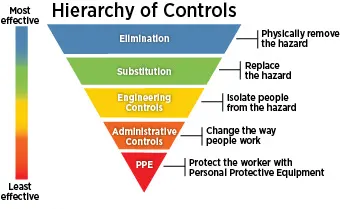Volatile Organic Chemicals (VOCs) within the domain of additive manufacturing are pollutants released from the manufacturing material (filament, resin, powder, and etc). These are the same chemicals released from automobile emissions, paint, solvents, adhesives, insulation, furniture, incense, and YES even the new car smell.
Quick Facts:
- VOCs are heavier than air and sink to the floor
- Concentrated exposure can cause mild symptoms but some will increase cancer risk
- Printing at higher temperatures emits more VOCs and particulates
- Using an enclosure decreases the particulate emission rate but increases VOC emission rates
- SLA resin is detrimental to the environment and should be regarded as toxic waste
- The exact health risks associated with SLA resin are not known due to proprietary formulas and the lack of research regarding safety
Example - Formaldehyde Boiling Point: -6° F (-21° C) Gaseous at Standard Atmosphere
Boiling Point: -6° F (-21° C) Gaseous at Standard Atmosphere
Formaldehyde is naturally produced in all living organisms and is used in countless consumer products. It is extensively regulated and typical exposure to the chemical is well within safety limits. However, 3D Printing is a manufacturing process and exposure levels are increased. Non-consistent use of entry level filaments with a single printer is unlikely to lead to the onset of symptoms in regards to formaldehyde emissions. Poor ventilation, multiple printers, industrial filaments, close proximity, and continuous use are factors that can contribute to the onset of symptoms.
| Formaldehyde Concentration mg/m3 |
Identifier |
|---|---|
| 0.00125 | Human Breath |
| 0.0025 | Outside Air |
| 0.01 | Chronic (lifetime exposure >364 days) Minimal Risk Level (MRL) by CDC |
| 0.025 | Indoor Air |
| 0.0375 | Intermediate (lifetime exposure 15-364 days) MRL by CDC |
| 0.05 | Acute (lifetime exposure 1-14 days) MRL by CDC |
| 0.03-0.09 | Level in 100ft Room - Internal Tests on Filaments (PLA/PETG/ABS) |
| 0.125 | Onset of Respiratory Irritation by OSHA |
| 0.191 | Peak Level Inside Chamber With PLA |
| 0.625 | Potential Cancer Hazard by OSHA |
| 1.25 | Jet Exhaust |
| 11.25 | Car Exhaust |
FFF/FDM Risks
Experimental data is compiled to provide a sense of the safety regarding specific filaments. Very few research studies have been dedicated towards determining the overall safety of additive manufacturing, and the ones that have been conducted are typically focused on entry level materials. More research will be needed on exotic materials to determine their safety.
| Common VOCs in Entry Level 3D Filaments | |||||||
| Emitted Substance | Example Filaments | Emission Rate mg/min |
Average Level mg/m3 |
Peak Level mg/m3 |
Tolerable Exposure Levels 24 Hours |
Tolerable Exposure Levels 4 Hours |
Notes |
| Caprolactam | Nylon, ABS, PC, PETG | 0.183 | 1.102 | 3.078 | 0.3 | 0.3 | Irritant |
| Styrene | ABS, HIPS | 0.113 | 0.681 | 2.479 | 0.25 | 1.5 | Irritant/Reasonably anticipated to be a human carcinogen |
| Tetrachloroethylene | PLA, ABS, PC | 0.0055 | 0.03 | 0.13 | 0.01 | 0.06 | Reasonably anticipated to be a human carcinogen |
| Formaldehyde | PLA, ABS | 0.191 | 0.1 | 0.1 | Irritant/Known to be a human carcinogen | ||
| Methyl Methacrylate | PLA | 0.0065 | 0.039 | 0.29 | 0.11 | 0.11 | Irritant |
| Lactide | PLA | 0.005 | 0.03 | 0.089 | 0.3 | ||
Danish Environmental Protection Agency; Risk Assessment of 3D Printers and 3D Printed Products
Stephens B, Crain N, Pouzet C, Zhao D, Azimi P; Emissions of Ultrafine Particles and Volative Organic Compounds from Commercially Available Desktop 3D Printers with Multiple Filaments
US Department of Health and Human Services, National Toxicology Program; 14th Report on Carcinogens
| Example Filament Comparisons to PLA | ||
| Filament | Particulate Generation Rate | Example Emissions |
| PLA | 1x | Methyl Methacrylate |
| PC | 4400x | Toluene |
| PETT | 100x | Caprolactam, Styrene |
| Flexibles (ie: TPU) | 3.5x | Toluene, Phenol |
| Colorfabb HT |
1100x | 2,4,4-Trimethyl-2-Pentene |
| BambooFill |
0.5x | Methyl Methacrylate |
| Nylon Co-polymers |
8x | Caprolactam |
SLA Risks
The primary SLA dangers involve inhalation and skin contact. The issue of skin sensitization is well known throughout the industry, and it is a symptom that is easily diagnoseable. For fumes, concentrated short term exposure results in only mild symptoms such as dizziness, headaches, and throat irritation. The long-term effects are unknown.
Take Action

https://www.cdc.gov/niosh/topics/hierarchy/default.html

Sources
- http://www.rjchase.com/ptfe_handbook.pdf
- https://www.cdc.gov/niosh/docs/2020-115/pdfs/2020-115.pdf?id=10.26616/NIOSHPUB2020115
- http://built-envi.com/portfolio/ultrafine-particle-emissions-from-3d-printers/
- https://formaldehyde.americanchemistry.com/Formaldehyde-Occurs-Naturally-and-Is-All-Around-Us.pdf
- https://www.ncbi.nlm.nih.gov/books/NBK138711/
- https://www.osha.gov/OshDoc/data_General_Facts/formaldehyde-factsheet.html
- https://pubchem.ncbi.nlm.nih.gov/compound/Formaldehyde#datasheet=LCSS
- https://www.atsdr.cdc.gov/mrls/mrllist.asp#39tag
- https://www.atsdr.cdc.gov/toxprofiles/tp111-c2.pdf
- https://www.cancer.gov/about-cancer/causes-prevention/risk/substances/formaldehyde/formaldehyde-fact-sheet
- https://www.chemicalsafetyfacts.org/formaldehyde/
Disclaimer: You assume all responsibility and risk for the use of, but not limited to, the resources, advice, and opinions of 4D Filtration or its employees. 4D Filtration or its employees do not assume any liability or create any warranty for the use of any information. 4D Filtration may receive commissions for referral links. Prices are approximated for simplicity and they may fluctuate due to sales or markdowns. Amazon .com should refer you to your local amazon site if you are not in the United States; there is a chance Amazon's link redirect system will take you to a different product.